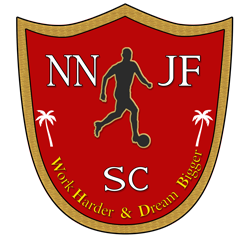Recovery and Injury Prevention
A Guide for NNJF SC Soccer Club Academy Players
Introduction
Recovery and injury prevention are vital components of a soccer player’s regimen, ensuring longevity and sustained peak performance. At NNJF SC Soccer Club Academy, we emphasize the importance of effective recovery strategies and injury prevention practices to maintain players' health and enhance their on-field performance. Whether you are an aspiring player or a seasoned professional, understanding and implementing these principles is essential. This article explores the significance of recovery and injury prevention and provides practical guidance for optimizing your training and game-day routines.
The Importance of Recovery and Injury Prevention
Sustained Performance
Proper recovery allows players to perform consistently at their best. It reduces fatigue, restores energy levels, and repairs muscles, enabling you to train and play at peak levels throughout the season.
Reduced Injury Risk
Injury prevention practices minimize the likelihood of injuries, keeping players healthy and available for selection. Preventing injuries not only protects your physical well-being but also ensures continuous development and contribution to the team.
Faster Rehabilitation
Effective recovery strategies expedite the healing process in the event of an injury. This reduces downtime, allowing players to return to training and matches sooner and in better condition.
Enhanced Mental Well-Being
Adequate recovery supports mental health by reducing stress and promoting relaxation. A balanced approach to training and recovery fosters a positive mindset, crucial for maintaining motivation and focus.
Long-Term Athletic Development
Injury prevention and recovery practices are essential for long-term athletic development. They ensure that players can progress through their careers with fewer setbacks, leading to sustained growth and achievement.
Practical Guidance for Recovery
Prioritize Sleep
Sleep is the cornerstone of recovery. Aim for 7-9 hours of quality sleep per night to allow your body to repair and regenerate. Establish a consistent sleep schedule and create a restful sleep environment to enhance sleep quality.
Post-Training Nutrition
Consume a balanced meal or snack within 30 minutes of training or matches to replenish glycogen stores and support muscle recovery. Include carbohydrates for energy replenishment and proteins for muscle repair.
Hydration
Maintain proper hydration by drinking water throughout the day and replenishing fluids lost during training and matches. Dehydration impairs recovery and performance, so ensure you stay adequately hydrated.
Active Recovery
Incorporate light activities such as walking, cycling, or swimming on rest days to promote blood flow and aid in the removal of metabolic waste products from muscles. Active recovery helps reduce muscle soreness and stiffness.
Stretching and Flexibility
Perform static stretching and flexibility exercises after training sessions to improve muscle elasticity and reduce the risk of muscle tightness. Yoga and Pilates can also enhance flexibility and relaxation.
Use of Recovery Tools
Utilize recovery tools such as foam rollers, massage balls, and compression garments to aid in muscle recovery. Foam rolling helps release muscle tension and improve circulation, while compression garments can reduce muscle soreness.
Cold and Heat Therapy
Alternate between cold and heat therapy to reduce inflammation and promote healing. Ice baths, cold packs, and contrast baths (alternating between cold and warm water) are effective recovery techniques.
Professional Massage
Regular sports massages from a qualified therapist can help alleviate muscle tension, improve circulation, and accelerate recovery. Schedule massages as part of your routine recovery plan.
Listen to Your Body
Pay attention to signs of fatigue, soreness, and discomfort. Rest when needed and avoid pushing through pain, as this can lead to injuries. Respecting your body’s signals is crucial for effective recovery.
Practical Guidance for Injury Prevention
Proper Warm-Up
Always perform a thorough warm-up before training and matches. Include dynamic stretches, mobility exercises, and sport-specific drills to prepare your muscles and joints for intense activity.
Strength and Conditioning
Engage in a well-rounded strength and conditioning program to build muscle strength, improve joint stability, and enhance overall physical resilience. Focus on exercises that target major muscle groups and address any muscle imbalances.
Correct Technique
Practice proper technique in all aspects of play, from running and jumping to tackling and shooting. Poor technique increases the risk of injuries, so seek guidance from coaches to ensure correct form and mechanics.
Gradual Progression
Gradually increase the intensity and volume of your training to avoid overloading your body. Sudden increases in training intensity or frequency can lead to overuse injuries, so follow a structured progression plan.
Wear Appropriate Gear
Use the right footwear and protective equipment for training and matches. Ensure your boots fit properly and provide adequate support and traction. Protective gear such as shin guards can prevent injuries during physical play.
Cool Down
Always include a cool-down period after training and matches. Light jogging and stretching help lower your heart rate gradually and reduce muscle stiffness.
Regular Medical Check-Ups
Schedule regular check-ups with sports medicine professionals to monitor your physical health. Early detection of potential issues allows for timely intervention and prevention of more serious injuries.
Mental Preparation
Mental readiness is key to injury prevention. Stress and lack of focus can lead to mistakes and increased injury risk. Practice mental training techniques such as visualization and mindfulness to enhance focus and reduce stress.
Individualized Programs
Work with coaches and medical professionals to develop individualized training and recovery programs that cater to your specific needs and goals. Personalized programs address your unique strengths and weaknesses, optimizing performance and injury prevention.
Conclusion
At NNJF SC Soccer Club Academy, we believe that effective recovery and injury prevention are essential for soccer excellence. By prioritizing recovery, maintaining proper nutrition and hydration, and incorporating injury prevention practices, you can sustain peak performance and reduce the risk of injuries. Whether you’re an aspiring player or a seasoned professional, remember that recovery and injury prevention require dedication, consistency, and a holistic approach. Embrace these principles, and watch as your resilience and longevity in the sport elevate your game to new heights.Top of Form
Bottom of Form
